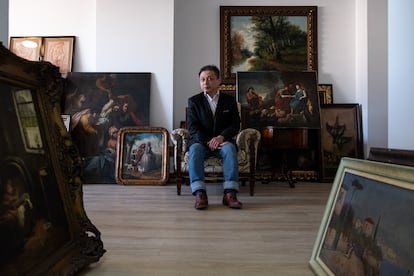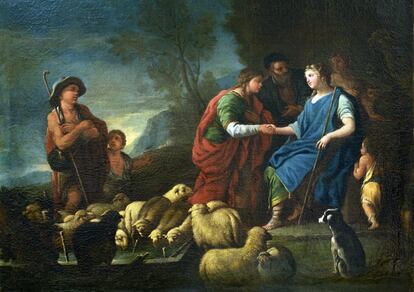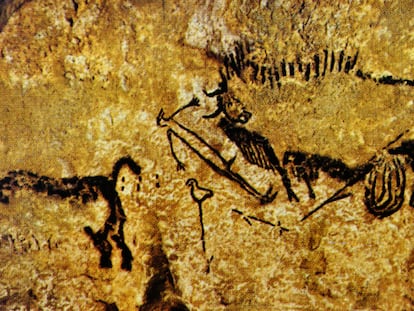A lost Rembrandt painting at the end of the world?
Liu Zhijiang, a businessman from the planet’s southernmost city, claims to have found a previously unknown work by the Dutch Baroque master


The news was first reported by El diario del fin del mundo, the local newspaper of Ushuaia, Argentina, the world’s southernmost city: one of its notable residents had discovered a 17th century painting in a flea market. The baroque painting depicted a biblical scene and could be worth hundreds of millions of dollars. Liu Zhijiang, a Chinese businessman who divides his time between operating a colossal fish processing vessel and collecting art, had no doubts — it was a lost Rembrandt and he could prove it. The news trickled out to the rest of the world. What was a painting by the great Dutch master doing at the end of the world in Patagonia?
Liu Zhijiang was born 55 years ago in Jinan, China, a city about 250 miles (400 kilometers) south of Beijing. The diminutive man, animated and polite, speaks a fast-paced Spanish with a thick Argentine accent that reflects living half of his life in the country. After studying fishing engineering in China, Liu lived for a couple of years in the Canary Islands and worked on fishing vessels off the coast of Morocco. He landed in southern Argentina in 1994. “I’ve watched Ushuaia grow over the years,” he said. “When I first arrived, the city had 20,000 residents and hardly any houses. It has grown to over 80,000 people. I’ve seen eight provincial governments come and go, and I’m still there.”
Liu gets his daily copy of EL PAÍS delivered to his office in downtown Buenos Aires, where we meet to talk about his discovery. It’s late April, during an intense, ongoing economic crisis. Year-over-year inflation is up to 104% and the Argentine government is scrambling for export dollars to brake the peso’s freefall. Liu is president of Prodesur, an industrial fishing company with 200 employees and a 325-foot (100 meters) ship that fishes Argentine waters and makes surimi (a minced fish paste often called imitation crab) for export. He is in Buenos Aires to meet with government officials from the Ministry of Agriculture, Livestock and Fisheries, and took time to show us some of his art collection. In his office are about 20 paintings, a few Chinese porcelain objects, ivory figurines and his latest treasure lying on the floor — an unframed canvas between two thick sheets of polystyrene.
The Old Testament scene of Jacob and Rachel at the well entranced Liu when he first saw it in a San Telmo art gallery in Buenos Aires. “An old business acquaintance called me and said he bought it from a German family in desperate need of money,” said Liu. “It was very dirty and didn’t look good. But the expression on Rachel’s face captivated me — it has a spiritual aura,” he said.

Liu says he bought it for $20,000 and spent months of pandemic confinement contemplating the painting. Rachel’s gaze at her future husband inspired Liu to write a novel about a young couple whose luck changes when they find a Rembrandt in one of the art galleries around the San Telmo antiques flea market. He is now looking for a production company to turn his novel into a movie. He also named one of his Ushuaia real estate development projects after the painting. But his most ambitious project is to build a museum in Ushuaia next year. The painting he discovered in San Telmo will be the centerpiece of the museum’s collection of 200 paintings and 300 art objects Liu bought over the years in Buenos Aires.
No expert has certified that the painting is a Rembrandt. The Dutch master who died penniless in 1669 left a vast body of work that has kept art experts busy trying to establish which are Rembrandts and which were painted by students and imitators. In 1968, the Dutch government funded the Rembrandt Research Project to scrutinize a 1930s-era catalog that listed over 600 pieces by the master. The latest expert consensus is that Rembrandt created approximately 350 paintings and hundreds of drawings. He also taught students and apprentices, leading to hundreds of incorrectly attributed works, forgeries and frauds.
In 2022, after Liu contracted the Tres de Febrero University in Buenos Aires to restore his painting, news that a Rembrandt had been found in Patagonia leaked out and quickly spun out of control. The university’s final report never attributes the painting, and simply describes an oil on canvas by an anonymous author, that “exhibits multiple previous restorations… and closely resembles a painting by the Neapolitan artist Luca Giordano [1634-1705] from the late 17th century.”
The study analyzed the painting’s materials and determined that the natural plant fibers of the “possibly linen” original canvas indicate a “pre-industrial fabric, consistent with the dating proposed” by its current owner. The lead, iron, aluminum, sulfur and potassium in the white and blue pigments are also consistent with 17th and 18th century materials. Those details, the religious subject and the similarity to Giordano’s work, led Liu to his own conclusions. “Giordano often made copies, so I think he saw this painting and imitated it.” Giordano’s Jacob and Rachel at the Well painting is part of the Prado Museum’s permanent collection in Madrid. “The colors, the depth and the girl’s gaze all make me think it’s by Rembrandt,” said Liu. The signature on his painting was lost during the restoration process.

The Tres de Febrero University cannot certify the age or authorship of a painting. “No Rembrandt entered or exited our center,” said Gabriela Siracusano, the director of the university’s art research center. “We only do chemical, historical and scientific research,” she said. Ángel Navarro, the curator of the National Museum of Fine Arts in Buenos Aires and a top Argentine expert on European art of the period, said, “Pigment and materials analysis is barely 3% of art certification process… What matters most are the stylistic aspects.” When Navarro examined the painting in late April, he said, “I realized it was Italian, not a Dutch painting at all. This is all much ado about nothing.”
Liu hopes to one day solve the mystery of his painting’s origin. He will consider it a Rembrandt until he can prove otherwise. “I don’t smoke, drink or gamble. My only vice is art,” he said, sitting in his office surrounded by paintings. His European art collection comprises paintings from Italy, Germany and Spain that probably came to Argentina after World War II. Nazi relics have been found in Argentina, but Navarro firmly says that no publicly exhibited German collection has any significant pieces. So, while the provenance of the Patagonian Jacob and Rachel at the Well remains a mystery, it’s a Rembrant only in the eyes of its owner that will soon be the centerpiece of a museum at the end of the world — and maybe a movie.
Sign up for our weekly newsletter to get more English-language news coverage from EL PAÍS USA Edition
Tu suscripción se está usando en otro dispositivo
¿Quieres añadir otro usuario a tu suscripción?
Si continúas leyendo en este dispositivo, no se podrá leer en el otro.
FlechaTu suscripción se está usando en otro dispositivo y solo puedes acceder a EL PAÍS desde un dispositivo a la vez.
Si quieres compartir tu cuenta, cambia tu suscripción a la modalidad Premium, así podrás añadir otro usuario. Cada uno accederá con su propia cuenta de email, lo que os permitirá personalizar vuestra experiencia en EL PAÍS.
¿Tienes una suscripción de empresa? Accede aquí para contratar más cuentas.
En el caso de no saber quién está usando tu cuenta, te recomendamos cambiar tu contraseña aquí.
Si decides continuar compartiendo tu cuenta, este mensaje se mostrará en tu dispositivo y en el de la otra persona que está usando tu cuenta de forma indefinida, afectando a tu experiencia de lectura. Puedes consultar aquí los términos y condiciones de la suscripción digital.
More information
Archived In
Últimas noticias
Most viewed
- Sinaloa Cartel war is taking its toll on Los Chapitos
- Oona Chaplin: ‘I told James Cameron that I was living in a treehouse and starting a permaculture project with a friend’
- Reinhard Genzel, Nobel laureate in physics: ‘One-minute videos will never give you the truth’
- Why the price of coffee has skyrocketed: from Brazilian plantations to specialty coffee houses
- Silver prices are going crazy: This is what’s fueling the rally









































